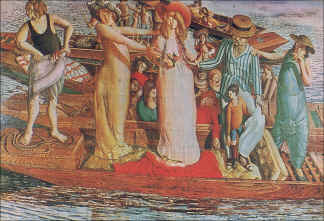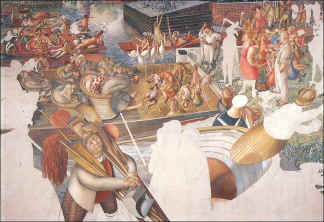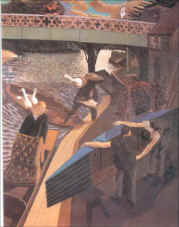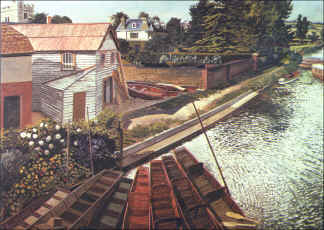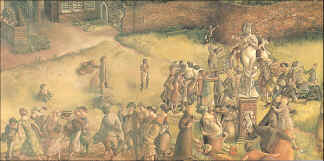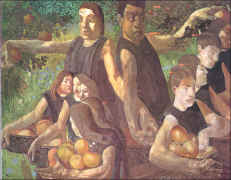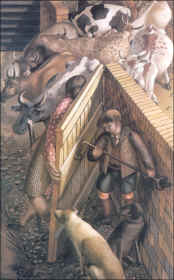
Dîner sur la pelouse d'hôtel (1956-7)
Huile sur la toile 95 x 136 centimètres
Écoute de Punts (1954)
Huile sur la toile 96,5 x 144,8 centimètres
Le Christ prêchant chez Cookham Regatta (1959)
Crayon et huiles sur la toile 207 x 534 centimètres
Le Resurrection, Cookham - détail (1923-7)Huile sur la toile 274 x 549 centimètres
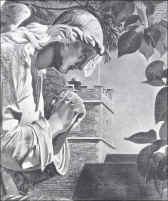
Roy (1906)
Crayon lecteur et encre 24,5 x 16,5 centimètres
Cygne se levant chez Cookham (1914-15)
Huile sur la toile 116,8 x 142,2 (terminé 1919)
Vue de Cookham Bridge (1936)
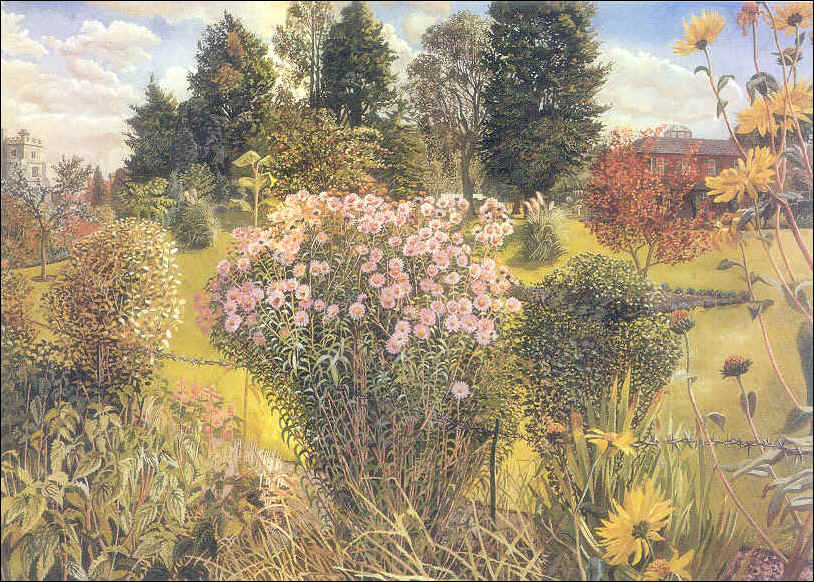
Bellrope Meadow (1936)
Huile sur la toile
91 x 129 centimètres 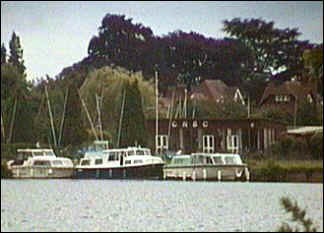

Le Magnolia Tree (1938)
Huile sur la toile 54,6 x 63,5 centimètres
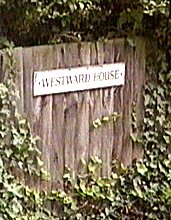
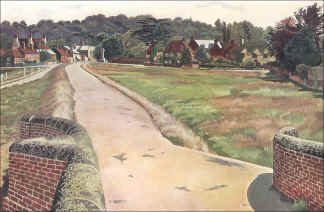
Cookham Amarrent (1937)
Huile sur la toile 49,5 x 75,6 centimètres

Les vaches chez Cookham amarrent 1936
Amour sur l'amarrage - détail (1949-54)
Huile
sur la toile 79,1 x 310 centimètres 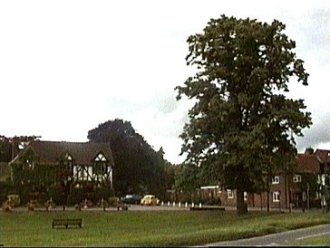
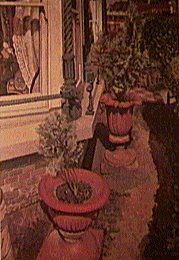
Villas chez Cookham (1938)
Huile sur la toile
76,5 x 52,3 centimètres
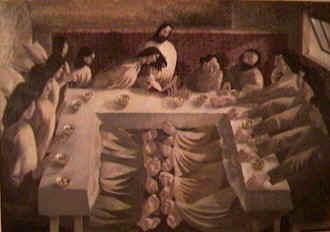
Dernier Supper (1920)
Huile sur la toile
91,5 x 122 centimètres
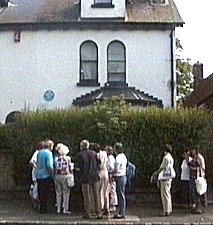
" Fernlea "
Grand-rue De Cookham
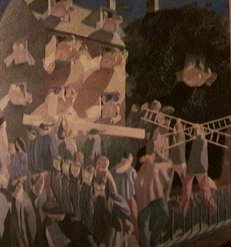
Huile sur la toile
153 x 143 centimètres
L'entrée du Christ dans Jérusalem (1921)
Huile sur la toile 114,2 x 144,8 centimètres
Pomme Gatherers (1912-13)
Huile sur la toile 71,4 x 92,5 centimètres
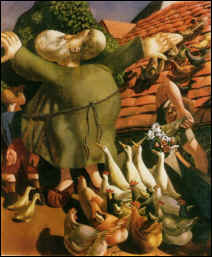
Rue Francis et les oiseaux (1935)
Huile sur la toile 71 x 61 centimètres
La Ferme Gate (1950)
Huile sur la toile 35 x 22,5 pouces
Si vous vous tournez vers la droite le fleuve regarde le plus ou moins même que quand il a été dépeint par Stanley Spencer. Notez le mur en bas du côté de la ruelle, ceci forme le fond au dîner sur la pelouse d'hôtel . C'est un exemple de la peinture méticuleuse des artistes des surfaces de brique. D'autres bons exemples peuvent être vus dans les peintures de la Chambre d'Englefield dans la galerie.
Retrace vos étapes à la ruelle d'Odney et à l'entrée au club d'Odney possédé par l'association de John Lewis. Dans le mur cinquante yards vers la gauche à l'entrée sont certains Windows ronds comme les trous gauches du bateau devant lesquels l'artiste a peint des filles retournant d'un baigner (1936) maintenant dans la galerie.
En retournant à la pierre goudronneuse,
traversez la route principale et prenez la rotation de mener à
l'église de Cookham . Le jeune Stanley Spencer a été fasciné par
le churchyard, il a écrit au sujet de ses chambres fortes avec les
balustrades lourdes et les pierres tombales de penchement. C'était là
qu'il a placé un de ses peintures plus importantes, le
Resurrection, Cookham . Du côté gauche sa première épouse
Hilda sent une fleur et il est la figure nue debout.
Judith
Whittet écrit une analyse intéressée qui mérite de lire. Elle a
été peinte dans le studio de l'agneau d'henry dans l'hôtel de Vale,
Hampstead, où elle a étiré la longueur entière de la salle. En
raison de la taille l'artiste a dû se tenir sur un cadre placé sur une
table pour peindre les sections supérieures de la toile. Un ami, Kate
adoptif, décrit l'artiste au travail " chancelant sur un cadre
tout en peignant les roses blanches dans un coin, juste une connexion à
la fois, et se tenant en avant de son altitude sur Tonks et le Slade.
" La peinture a été inspirée par description de John Donne d'un
churchyard en tant qu'étant " la banlieue sainte dans le ciel
". Nouvellement ressuscités émergent de mode insouciante pour éprouver
la joie de leur nouveau paradis latéral de la Tamise. **time-out** Dieu
père et Christ, avec un enfant dans son bras, voir dans fleur couvrir
porche centre et occuper par plusieurs prophète. Vers leur droite par
groupe de nègres émergez de leur propre patrie. Dans les expositions
de Spencer de premier plan être mauvais shepherded dans les coins des
tombeaux ' genre boîte '.
Stanley Spencer a peint l'ange (1953) qui est sur votre gauche pendant que vous écrivez la porte d'église, et plusieurs peintures du churchyard. L'ange apparaît également dans le coin droit supérieur des parents ressuscitant 1933 . La peinture montre l'ange en pierre avec la tour d'église dans le fond. Promouvez vers le bas du côté gauche de la voie d'accès est une pierre commémorative à l'artiste, avec un arbre de Judas planté par les amis de la galerie de Stanley Spencer pour commémorer le centenaire de sa naissance.
Bien qu'il n'y ait aucune peinture par Stanley Spencer s'arrêtant dans l'église, qui a un intérieur en grande partie médiéval et est bonne en valeur une visite, il a placé une partie de son travail à l'intérieur. Le crayon lecteur et l'encre populaires dessinant Roy ont été dessinés par l'artiste quand il était quinze montrant un jeune garçon se penchant au-dessus d'un pew à l'intérieur de l'église. Elle est un de ses schémas de crayon lecteur plus tôt et d'encre. Le garçon est Roy de dentelle. Ce schéma peut être vu dans la galerie. En Stanley 1957 Spencer peint dans l'église , dépeignant l'intérieur comme il s'est rappelé le dans sa jeunesse avec le choeur dans le cortège.
De la prise d'église la voie d'accès après la porte occidentale menant par l'intermédiaire d'une porte de baisers au fleuve. Stanley Spencer a écrit de l'prise par son père à la porte de baisers au crépuscule pour entendre les hiboux " ronfler ".
Au towpath, tournez à droite vers la passerelle que Stanley peint a serrée des personnes en 1920. Peu un plus tôt il avait peint le cygne se levant chez Cookham commencé en 1915 et terminé sur son retour de la guerre en 1919. Le thème de la peinture est le cygne annuel se levant ou houblonnage de cygne, où les fonctionnaires des compagnies de Vintners et de Dyers, qui par permis royal possèdent les cygnes sur le fleuve la Tamise, rassemblent les jeunes oiseaux pour le mA rking. In the picture the birds are taken ashore in carpenters' bags at the landing stage The idea came to Spencer in church. "I could hear the people going on the river as I sat in our north aisle pew. " This painting also shows the bridge and Turk's boatyard which appears in another painting View from Cookham Bridge (Turk's Boatyard). Captain Turk was the Queen's Swan Upper. This ceremony still continues in July each year. Turk's Boatyard appears in two other of Spencer's paintings, The Boatbuilder's Yard, Cookham 1936 and Turk's Boatyard, Cookham 1936.
Retrace your steps and continue along the towpath for about 200 yards. On you left is the newly built Civil Service Retirement Home, the whole of this area was the setting for Bellrope Meadow . This painting provides an example of the artist's remarkable detailing of flowers and plants for which he is less will known that for his religious work. The gallery has examples of his flower painting in the Englefield House series. For this work Stanley Spencer used very fine brushes and there are on view in the memorabilia case in the gallery. Bellrope Meadow shows a view from the riverbank across Cookham with the tower of the church standing above the trees on the left. The house on the right was called 'Cookham End'. It was demolished and an old peoples' home 'Cookham House', was built on the site. Bellrope Meadow is also the setting for By the River 1935.
Just before the Sailing Club turn to the left up the path which runs between the club on your right and Cookham House on your left. But before doing so glance at the view ahead, still little changed, of the fields and the river bank; these were the settings for By the River (1935) and Cookham-on-Thames (1937).
Now follow the pathway which leads via a large metal gate bearing left into Berries Road. Towards the end of this road, to the right, is Westward House where you will see The Magnolia Tree painted by Stanley Spencer. It is in the front garden on the right hand side of the house. This is another fine example of the artist's beautiful painting of flowers. He wrote to tell Dudley Tooth that it was "as good as anything I have done. "
Opposite the end of Berries Road is the War Memorial, erected in 1921. Among others it commemorates the death in the first World War of Sydney Spencer MC, one of Stanley Spencer's brothers. Here Spencer painted A Village in Heaven 1937, which is set on the edge of Cookham Moor by the War Memorial, where the village girls traditionally came to meet their lovers. One of the disciples stands by the Memorial and gives his blessing to the young lovers. Its theme is the redemption of the world by sexual love which has become free of all shameful associations . To your right is Cookham Moor. This area is the site of several pictures painted just before World War II including Cookham Moor , Cows at Cookham and Love on the Moor . Cookham Moor shows the road leading over the Moor with the War Memorial and the village in the background. At the time the artist was also working on the compositions for From the Rise 1954, which was set by the bridge, seen in the foreground of this painting. The delightful painting of Cows at Cookham Moor is taken from one of the illustrations Spencer did for an Almanac published by Chatto & Windus in 1927. The two children are probably his daughters, Shirin and Unity.Spencer seemed to be particularly fond of the cows which ambled across the Moor and over the causeway. They reappear in Love on the Moor 1937-55 calmly chewing the cud behind the fertility statue. Cows also frequently occured in his notebooks.
The War Memorial is depicted in several of the artist's painting, Unveiling Cookham War Memorial (1922), A Village in Heaven (1937), Adoration of the Girls (1937) and the Jubilee Tree (1936). In that last painting the Jubilee tree is a sapling protected by fencing. It has now grown into the very tall tree you can see on your right in front of the Crown Hotel .
Walk a little way up School Lane and on the right are two houses with interesting front windows decorated with barley sugar ironwork. These are depicted in Villas at Cookham . Spencer was often disparaging about landscapes like this, which took him away from the more important figure painting. It was painted before the onset of financial pressures of the late thirties and early forties, which sometimes caused him to cut corners in an attempt to provide an early saleable work.
On the other side of School Lane was the site of the former malthouse where the artist set probably the most well-known of his religious paintings The Last Supper . In 1915 Spencer made his sketch of the Last Supper and then in 1919 he returned to the subject. He reported to his friend Henry Lamb ' I have nearly finished a composition of the Last Supper which I think you will dislike in the same way that you dislike the Entombment.' However, it was not until 1920 that he was able to begin work on the painting, which he completed during the summer of that year. He wrote to Lamb again to report that he had completed The Last Supper , but he felt it 'has not got the nice feeling that the drawing has got somehow'. His own doubts were not shared by others and there was talk of the Contemporary Art Society buying it, however Henry Slessor 'liked it so much' he duly purchased the picture for 150. The scene of The Last Supper takes place inside the Cookham malthouse with the red wall of a grain bin in the background. Christ is shown at the moment he breaks the bread and, in accordance with tradition, St John sleeps on his shoulder. The composition belongs to his early 'Giottesque' style of large broadly-painted figures in a simple architectural setting. The extraordinary device of the legs protruding from under the table was a later addition, first appearing in the 1919 study. Spencer's own feelings about the painting were mixed. Writing in 1937, he commented "I lied the red wall among the sandy coloured ones. Could not get the feeling of the place which at the beginning was indivisible from the concept I had of Christ, but I could never get it in the picture. The original now hangs in the gallery with a copy in Holy Trinity Church . Also on the left hand side of School Lane is The Brew House (1957), painted by Stanley Spencer.
Return to the War Memorial and turn into the High Street. Halfway up on the right side is Fernlea, marked with a blue plaque, where Stanley Spencer was born and where he and his family lived for many years.
The artist looked upon the High Street as the nave of a church and he made it the setting for many of his paintings. These include Christ Carrying the Cross Christ's Entry into Jerusalem and Sarah Tubb and the Heavenly Visitors (1933) now owned by the gallery. Christ Carrying the Cross was inspired by a Daily Mail report the death of Queen Victoria which he saw quoted as journalistic sensationalism. It ran "Women publicly wept and strong men broke down in side streets. " This suggested to Spencer that at the death of Christ, that the Virgin, who is shown in the background, might have moved into a side street to be unobserved. The house is Fernlea and the ivy covered cottage The Nest, which belonged to his grandmother. When planning the painting he saw Fairchilds the builders' men going past The Nest carrying their ladders. Spencer painted Sarah Tubb and the Heavenly Visitors from a story recounted to him by his father. Sarah saw Halley's Comet flying over Cookham and thought it was the end of the world. Spencer painted her with angels in attendance trying to calm her down. The painting was willed to the Stanley Spencer Gallery by Barbara Karmel , who wanted her pictures by Spencer kept together after her death. The rear garden of Fernlea was the setting for an early painting, The Apple Gatherers . Stanley Spencer called this his first ambitious work, and it won him a Slade School prize in 1913. Just before the artist's death, he told his brother that The Apple Gatherers was painted over his first attempt to paint a Resurrection. This painting shows the artist's interest in Gauguin, which can be seen in the faces.
Also set in the High Street was The Dustmen or The Lovers (1934) and St Francis and the Birds . These two paintings were rejected by the Royal Academy in 1935 which caused Stanley Spencer to resign. A review in the Field said "When he paints St Francis of Assisi as a distorted doll followed by chicken and ducks, he shows a fault, not of the painter's hand, but of his head and heart. " The Dustman or The Lovers shows the newly resurrected dustmen and labourers being reunited with their wives in front of a cottage garden. In 1937 Spencer described the painting as "...the glorifying and magnifying of a dustman. The joy on his bliss is spiritual in his union with his wife who carries her in his arms and experiences the bliss of union with his corduroy trousers... they are gazed at by other reuniting wives of old labourers ". The discarded rubbish which the labourer and his wife offer up to the dustman couple had a significance for Spencer; "what is rubbish to some people is not rubbish to me and when I see things thrown away I all eyes to see what it is. " "These things were bits of lives of people to whom they belonged and express their characters ". "Nothing I love is rubbish and so I resurrect the teapot, and the empty jam tin and the cabbage stalks, and as there is a mystery in the Trinity, so there is in these three and many others of no apparent significance. " St Francis and the Birds was inspired by two of St Francis' books. According to the artist the composition was developed from a drawing showing Hilda Carline reading on a haystack, with a flock of chickens and ducks on the ground below. The large figure of the saint corresponds to the outline of the haystack. Spencer said that the painting "was imagined by the memory of his father in a dressing gown going to the larder in the passage between Fernlea and the Nest to get food for the hens and ducks. On the opposite side of the High Street, to the right of the garage is Ovey's Farm where he painted The Farm Gate . This was his diploma painting for his re-election in 1950 to the Royal Academy where it now hangs.
Towards the end of his life Stanley Spencer was commissioned by Aldenham School to provide a picture for the school chapel. The result was The Crucifixion (1958), a striking picture in which he imagined the cross wedged across the High Street "like a crashed airliner ". The pile of earth in the foreground with the figure of the fainting virgin lying on top was inspired by pipelaying operations in the High Street, which Spencer saw while composing the pcture. Spencer shocked the boys of Aldenham School by telling them "I have given the men who are nailing Christ on the Cross Brewers caps, because it is your Governors and you, who are still nailing Christ to the Cross. " The setting of Cookham High Street attracted Spencer because of the perspective formed by the roofs of the receding towards the east end of the village.
You are now almost back at the Stanley Spencer Gallery where the walk started.
Acknowledgements:
Permission to reproduce the following paintings is gratefully acknowledged:
The Royal Academy: The Farm Gate
Manchester City Art Galleries: Cookham Moor
Leeds City Art Gallery: Christ's Entry into Jerusalem
Walker Art Gallery , Liverpool : Villas at Cookham
Rochdale Art Gallery : Bellrope Meadow





